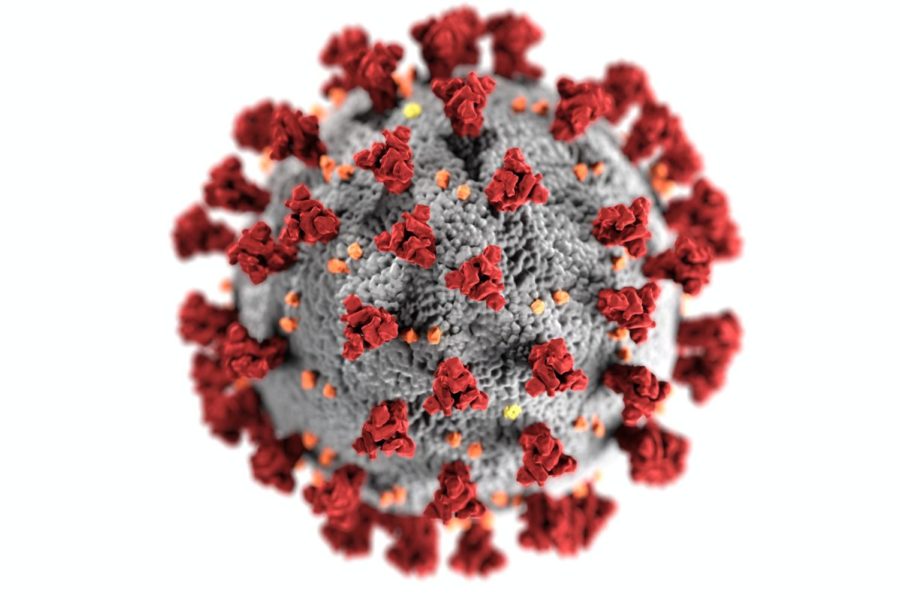How the SARS-CoV-2 Coronavirus Mutates
March 9, 2021
At the end of 2019, the novel coronavirus was identified in Wuhan, China. After a multitude of pneumonia cases arose, the virus caused many to garner concern over a potential world-wide outbreak, leading government officials and epidemiologists all over the world to initiate a global lockdown. Typically, emerging viral diseases are not made by new viruses but by pre-existing viruses such as H1N1, HIV, Ebola, and Zika. Viruses have a strict host range, and their genetic code continually changes, meaning that they can only infect a small number of hosts.
A virion is made up of nucleic acids that are wrapped in a capsid that consists of proteins. Particular virus strains may have an extra membrane, also known as the lipid bilayer and surrounding it is called an envelope. The coronavirus specifically has spike proteins shaped like a crown that function as a way for the virus to fuse into a cell’s membrane infecting it with its RNA genome. The host then reads the virus’s genetic code as its own and replicates it.
During the viral infection process, mutations are most likely to occur when genome replication is taking place. Mutations are when viruses replicate; however, an error can occur when the genetic code is being translated into proteins. This could mean that a piece of genetic code was either deleted, substituted, or inserted into the virus’s strand. There are three stages of a viral infection: entry, genome replication, and exit. The entry stage is when its protein receptor recognizes the virus. The ACE-2 protein receptor was discovered as the coronaviruses protein receptor. The next step is genome replication, where mutations are prone to occur, causing numerous strands of viruses. After the virus’s genome is collected, it will form to create a progeny virion particle to be released extracellularly hence being the exit stage.
There have been multiple variants identified of the SARS-CoV-2 coronavirus in England, Brazil, California, South Africa, and other locations. The variant in southeastern England was discovered in September 2020 that is now commonly known as B.1.1.7 has covered about 60% of the new December 2020 COVID cases throughout the United Kingdom, according to John Hopkins Medicine. This variant is the primary form of coronavirus in some countries as well. People may be able to get reinfected by a different variant called B.1.351, which was discovered in South Africa. The B.1.351 variant may be resistant to the developing coronavirus vaccine, however; it has become well-known that if the protein spikes on the virus change drastically the vaccine can still protect someone from having this specific strain of Coronavirus. OSF HealthCare announces that, “Research shows the antibodies created after vaccination will recognize and respond to many variations of the spike protein. This leads experts to be fairly confident the vaccines will continue to be effective against many mutations that may arise.”
It is inevitable that the Coronavirus is going to mutate as it continues to prosper across the world. The CDC publicizes, “As of March 4, 2021, 82.6 million vaccine doses have been administered.” It’s plausible to realize the importance of this vaccine because the quicker the people receive the vaccine the more effective it will be at reducing the rate of the mutations and the spread.
Sources
Bollinger, Robert, and Stuart Ray. “New Variants of Coronavirus: What You Should Know.” Johns Hopkins Medicine, www.hopkinsmedicine.org/health/conditions-and-diseases/coronavirus/a-new-strain-of-coronavirus-what-you-should-know.
Haseltine, William A. “What Are The 677 Mutations? New Covid-19 Variants Found In The US.” Forbes, Forbes Magazine, 19 Feb. 2021, www.forbes.com/sites/williamhaseltine/2021/02/19/what-are-the-677-mutations-new-covid-19-variants-found-in-the-us/?sh=4991298654ae.
Jack, Leonard. “Surveillance for SARS-CoV-2 Variants.” Centers for Disease Control and Prevention, Centers for Disease Control and Prevention, www.cdc.gov/coronavirus/2019-ncov/cases-updates/variant-surveillance.html?CDC_AA_r.
Nightengale, Laura, et al. “How COVID-19 Mutates and How It Affects Vaccines.” OSF HealthCare Blog, 14 Jan. 2021, www.osfhealthcare.org/blog/how-covid-19-mutates-and-how-it-affects-vaccines/.
Ryu, Wang-Shick. “Virus Life Cycle.” Molecular Virology of Human Pathogenic Viruses, U.S. National Library of Medicine, 2017, www.ncbi.nlm.nih.gov/pmc/articles/PMC7158286/#:~:text=produce%20progeny%20viruses.-,The%20multiple%20steps%20involved%20in%20the%20virus%20propagation%20occurring%20inside,%2C%20genome%20replication%2C%20and%20exit.
WHO. “Archived: WHO Timeline – COVID-19.” World Health Organization, World Health Organization, www.who.int/news/item/27-04-2020-who-timeline—covid-19.





